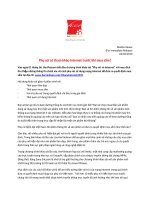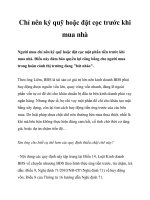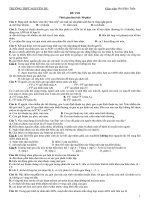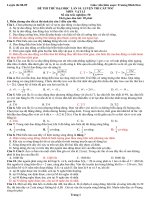Được phép thử trước khi mua
Bạn đang xem bản rút gọn của tài liệu. Xem và tải ngay bản đầy đủ của tài liệu tại đây (148.47 KB, 8 trang )
<span class='text_page_counter'>(1)</span><div class='page_container' data-page=1>
<b>UNIT 3. THE WORLD OF WORK</b>
<b>Level: Elementary</b>
<b>Time allowance: 180 minutes</b>
<b>Class size: </b>
<b>Aims: </b>
<i>Introduce students the grammar point on the present simple with the third person </i>
<i>singular; provide students with variety of jobs with related activities; the lesson also </i>
<i>focuses on how to tell the time in English</i>.
<b>Objectives: By the end of the lesson, students will be able to </b>
- Use the present simple with the third person singular.
- Enrich a variety of vocabulary on job with related activities.
- Ask and tell the times in English.
<b>Anticipated problems: </b>
<b>Procedure</b>
PERIOD 1
<b>Content</b> <b>Time</b> <b>Teacher’s activities</b> <b>Students’ activities</b>
STARTER 5
mins
- Give some examples of jobs
of the people in my own family
<i>My father is a teacher</i>
<i>My mother is a doctor</i>
<i>My sister is a nurse.</i>
<i>… </i>
- Get students to continue the
activity in pairs. If students ask for
the names of individual jobs, give
some examples that are common to
the whole class, but do not let the
Starter activity go on too long or
reduce the usefulness of the
Vocabulary and pronunciation
section.
- Listen and take note
- Work in pairs and tell the
partner the jobs of the people in
their family.
THREE JOBS
<i>Present simple </i>
5
mins
<b>Activity 1</b>
- Ask students to look at the
photographs. Ask them <i>What's his </i>
<i>job?</i> (music professor), <i>What's her </i>
<i>job</i>? (doctor). Then ask them to look
quickly at the texts and ask <i>Where's </i>
<i>he from</i>? (Budapest in Hungary),
<i>Where’s she from?</i> (Canada).
- Check students’ answers.
- play the recording and ask your
students to read and listen to the
texts at the same time
- Ask some students to read the text
aloud
- Look at the photographs and
answer the questions.
- Listen and read the text aloud
as a class.
- Work individually
5
mins
<b>Activity 2</b>
- Ask students to underline all the
verbs in the texts.
</div>
<span class='text_page_counter'>(2)</span><div class='page_container' data-page=2>
- Ask the whole class what the last
letter of these verbs is and point out
that this is the ending for the third
person singular - he, she, it- of the
Present Simple tense.
- ask students to chorus the sound /s/
and /z/ from the board and draw
their attention to the different
pronunciations of the endings.
- ask them to practice the verbs in
pairs and read one of the texts to
each other. Go round and monitor.
You could round off the activity by
asking one or two students to read a
text aloud to the whole class.
partner
- Listen and take note.
- listen and repeat chorally.
- Practise pronouncing the verbs
in pairs.
10
mins
<b>Activity 3</b>
<i><b>Prensent the present simple </b></i>
<i><b>she/he/it</b></i>
Form
Positive
<b>He/she/it + Vs</b>
<i>She lives in Hanoi</i>
<i>He works in a hospital</i>
Negative
<b>He/she/it + doesn’t + V</b>
<i>He doesn’t live in Australia</i>
Questions
<b>Wh + does + she/he/it + V?</b>
<i>Where does she live?</i>
Yes/no question:
<b>Does + she/he/it + V?</b>
<b>Yes, she/he/it + does</b>
<b>No, she/he/it + doesn’t</b>
<i>Does she live in Australia?</i>
<i>No, she doesn’t</i>
- listen and take note in
notebooks
5
mins
<b>Activity 4</b>
- Ask students to complete the
sentences about Istvan and Pamela.
- Listen and check the answers.
- Ask students to read the sentences
aloud.
- Work in pairs and complete the
sentences.
- Listen and check the answers
- Read the sentences aloud.
PRACTICE
<i>Talking about </i>
<i>people</i>
5
mins
<b>Activity 1</b>
- Ask students to read information
about Fernado.
- Work individually to read
information about Fernado.
5
mind
<b>Activity 2</b>
- Ask students to talk about Fernado
- Go around the class and provide help
if necessary.
</div>
<span class='text_page_counter'>(3)</span><div class='page_container' data-page=3>
5
mins
<b>Activity 3</b>
- ask students to write some notes
about a friend or relative.
- Go round the class to check and help
them. Bring the whole class together
again, and ask one or two students to
tell the others about their
friend/relative.
- Write some notes about a friend
or relative
- Students work in pairs and talk
about their friend/relative to their
partner
<i>My friend is Mary. She lives in </i>
<i>Ha Noi. She works …</i>
PERIOD 2
WHAT DOES HE
DO?
<i>Questions and </i>
<i>negatives</i>
5
mins
<b>Activity 1</b>
- Ask students to listen to the
recording and then complete the
answers.
- Play the recording again and get
students to repeat both chorally and
individually. Then get them to ask and
answer the questions in open pairs
across the class.
- Listen and complete the
answers.
-Listen and repeat chorally
- Ask and answer the questions
in open pairs across the class.
5
mins
<b>Grammar spot</b>
- Present the present simple tense
- make sure students understand that
<i>What does she/he do? </i>means the
same as <i>what's her/his job? </i>but that
<i>what does she/he do? </i>is the more
normal question.
- Ask students to listen and notice
the pronunciation of <i>does</i> and
<i>doesn’t</i>
- listen and take note
- listen and repeat
- Practise saying the question and
short answer.
5
mins
<b>Activity 2</b>
- Ask students to complete the
sentences on their own and then
check their answers with a partner.
- Play the recording and get them to
listen and check.
- ask individuals to read aloud their
answers to the class and check the
pronunciation.
- Work individually
- Listen and check the answers.
- In turn, read aloud their
answers to the class.
5
mins
<b>Activity 3</b>
- Ask students to write similar
questions about Fernando the tourist
guide.
- Ask students to ask and answer
questions with a partner.
- Go around the class and check
pronunciation.
- Work individually to write
questions about Fernando.
- Ask and answer questions in
pairs.
<i>A; Where does Fernando come </i>
<i>from?</i>
<i>B: Peru</i>
</div>
<span class='text_page_counter'>(4)</span><div class='page_container' data-page=4>
PRACTICE
<i>Asking about </i>
<i>people</i>
<i>Listening and </i>
<i>pronunciation</i>
5
mins
<b>Practice 1</b>
- Get students to read about Iman or
Giorgio. Check comprehension and
drill the pronunciation of some new
words
- work individually to read about
Iman and Giorgio.
5
mins
<b>Practice 2</b>
- Get students to say a sentence
about each person as an example.
- Ask students to choose Iman or
Giorgio and describe her/him to a
partner.
- Go round the class to check and
help students. Round off the activity
by bring the whole class together
again and asking one or two
students to tell the class about Iman
and Giorgio.
- Say a sentence about Iman and
Giorgio.
- Work in pairs and describe
Iman or Giorgio to the partner.
<b>Sample</b>
<i>Iman’s a model and </i>
<i>businesswoman.</i>
<i>She comes from Somalia</i>
<i>She lives in New York</i>
<i>…</i>
5
mins
<b>Practice 3</b>
- Ask each student in a pair to
choose either Iman or Giorgio.
Students work on their own and
write questions about their character
- Check their questions quickly
round the class, getting students to
read them aloud.
- Write questions about Iman or
Giorgio.
<b>Sample</b>
<i>What does he do?</i>
<i>Where does he come from?</i>
<i>Where does he live?</i>
<i>Where does he work?</i>
…
5
mins
<b>Practice 4</b>
- Ask your students to close their
books. Write the names Iman and
Giorgio on the board, then ask
students to work in pairs and take it
in turns to ask and answer questions
about them.
Let students choose their questions
and character they use.
- Round off the activity by asking
for a few questions and answers in
open pairs across the class.
- Work in pairs. Ask and answer
questions about Iman and
Giorgio in turns.
<i>A: what does Iman do?</i>
<i>B: She’s a model and </i>
<i>businesswoman.</i>
<i>A: Where does she come from?</i>
<i>B: She’s from Somalia</i>
<i>…</i>
5
mins <b>Practice 5</b>- Ask students to work in pairs to
ask the same questions about a
friend or relative of theirs.
- Go round and check as they do the
activity, focusing on the formation
of questions. Ask one or two
students to tell the whole class about
their or their partner's relative.
- Work in pairs to ask questions
about a friend of the partner.
5
mins
<b>Practice 6</b>
- Ask students to listen to the
sentences about Iman and Giorgio.
</div>
<span class='text_page_counter'>(5)</span><div class='page_container' data-page=5>
Then correct the wrong sentences
about them.
- Encourage other members of the
class to correct if a wrong answer is
given.
Iman and Giorgio. Correct the
wrong ones.
<i>R: Iman comes from Somalia.</i>
<i>S: Yes, that’s right.</i>
<i>R: Iman lives and works in </i>
<i>Somalia.</i>
<i>S: No, she doesn’t. She lives and </i>
<i>works in New York.</i>
…
2
mins
<b>Practice 7</b>
- Ask students to listen to the
recording and tick the sentence they
hear.
- Check the answers by playing the
recording again.
- work individually and tick the
sentence they hear.
3
mins
<b>Practice 8</b>
- Ask students to work small groups
and tick the correct sentence. Ask
them to work quite quickly, then
conduct a full class feedback. Try to
get students to correct each other
and explain any mistakes they hear.
- work in groups of 4 and tick the
correct sentence.
PERIOD 3
READING AND
LISTENING
10
mins
<b>Activity 1</b>
- Ask students to look quickly at the
photographs on the page and tell
you a little about what and who they
can see. Briefly revise the times that
go with each photograph
- Ask students to work in pairs and
match the sentences with the
photographs. Tell them not to worry
about new vocabulary but to use the
words that they recognize and the
information in the photographs to
help them with the matching.
- Check the answers.
- Check the key vocabulary by
giving short definitions
accompanied by mime and getting
students to tell you the word
e.g. <i>You eat this in the morning - </i>
<i><b>breakfast;</b></i>
<i>the people who stay in a hotel </i>
<i>-<b>guests</b>; </i>
<i>you need this in your</i>
<i>car to drive it -<b>petrol</b>, </i>etc.
- Look quickly at the
photographs and listen to the
teacher.
- Work in pairs to match the
sentences with the photographs.
- listen and do the guessing.
10
mins
<b>Activity 2</b>
</div>
<span class='text_page_counter'>(6)</span><div class='page_container' data-page=6>
and then answer the questions that
follow.
- Pre-teach some of the key
vocabulary before the students start
to read, so that they do not stop at
every word thev do not recognize to
ask for an explanation.
- Teach the following through mime
or short definitions:
jobs - policeman, fireman,
<i>taxi-driver,school-bus driver, boatman </i>(a
man you pay to take youout in a
boat or for the use of a boat),
<i>ambulance man,</i>
<i>petrol attendant, undertaker; </i>
verbs - get up, make breakfast,
<i>watch TV, make supper, go to bed.</i>
<i>- </i> Check the answers.
- Read about Seumas
individually and then discuss
with a partner to answer the
questions.
- Listen to the teacher and take
note.
10
mins <b>Activity 3- Ask </b>students to look back at the
photographs. Then ask and answer
question with a partner about times
in Seumas’s day.
- Demonstrate the activity by getting
two students to ask and answer
using the example in the Student's
Book.
- Ask students to continue to ask and
answer questions about the times in
Seumas's day. Go round the class to
check. Feed back on any common
errors.
- Work in pair and look at the
photographs
- Ask and answer questions about
times in Seumas’s day.
<i>A: what does he do at 6 o’clock?</i>
<i>B: He gets up and make </i>
<i>breakfast.</i>
<i>A: what does he do at 8 o’clock?</i>
<i>B: He drives the children to </i>
<i>school</i>
<i>…</i>
5
mins
<b>Activity 4</b>
- Ask students to listen to 4
conversations from Seumas’s day.
After each one answer the questions
that follow.
<i>Is it morning, afternoon or evening?</i>
<i>Who are the people? Where are </i>
<i>they?</i>
<i>What is Seumas’s job?</i>
<i>- </i>Check the answers with the whole
class.
- Listen to 4 conversations and
answer the questions.
10
mins
<b>Activity 5</b>
- Ask students to complete the
conversations as far as they can,
using what they can remember from
the first listening and from the
reading text, and the information
from activity 3. Students can then
</div>
<span class='text_page_counter'>(7)</span><div class='page_container' data-page=7>
exchange information with
a partner.
- Play the conversations again to
allow students to complete their
answers. Then check the answers
with the whole class.
- Put students into pairs to practise
the conversations.
- Check the answers.
- Practise the conversation in
pairs.
PERIOD 4
VOCABULARY
AND
PRONUNCIATION
<i>jobs</i>
15
mins
<b>Activity 1</b>
- Ask students to look at the pictures
and tell you any of the jobs they
know already.
- get them to work in small groups
and match a picture with a job in
column A<b>,</b> checking any words that
are still unknown in their
dictionaries.
- Ask students to match a job in A
with a line in B
- Ask students to listen to check the
answers.
- Ask student to repeat the jobs in
chorus.
- look at the pictures and guess
the new words.
- Work in groups of 4 and do the
matching. Use dictionary for any
new words.
- Work in groups of 4 and match
a job in A with a line in B.
- listen and check the answers.
- Practise pronouncing the jobs
chorally.
10
mins
<b>Activity 2</b>
- Ask the whole class to look at all
the phonetic transcriptions and see if
they can recognize any of the words
- ask them to write the spellings of
the words and then check them with
a partner and practise saying them
together.
- Ask students to listen and repeat.
- Work in pairs and guess the
words from transcriptions.
- write the spellings of the words
in pairs.
- Listen and repeat.
20
mins
<b>Activity 3</b>
- Ask students to learn the sentences
in activity 1 by heart. Then close
their books, calll out the name of a
job and tell your students to call out
to complete the sentence.
- ask students to work in pairs for a
few minutes with their books still
shut, and ask and answer questions
about the jobs. Demonstrate the first
example yourself to remind them of
the question
<i>T: What does a pilot do?</i>
<i>S: He flies planes</i>
<i>T: what does a chief do?</i>
- learn the sentences by heart,
then close book and complete the
teacher sentences
<b>Sample</b>
<i>T: A pilot</i>
<i>S: Flies planes</i>
<i>T: A chief</i>
<i>A: cooks in a restaurant.</i>
<i>…</i>
</div>
<span class='text_page_counter'>(8)</span><div class='page_container' data-page=8>
<i>S: He cooks in a restaurant.</i>
<i>…</i>
<i>- </i>Go round the class and check
pronunciation.
PERIOD 5
EVERYDAY
ENGLISH
<i>What time is it?</i>
5
mins
lntroduce the subject of telling the
time by asking <i>What time is it now? </i>
and <i>what time does the lesson end? </i>
Accept answers in the <i>hour +</i>
<i>minutes</i> form, e.g. <i>five thirty, </i>but
explain that the system used in <i>New </i>
<i>Headway Elementary </i>uses <i>past </i>and
<i>to.</i>
- Listen to the teacher
15
mins
<b>Activity 1</b>
- Ask
students to work in pairs,look carefully at the clocks, and
write in the times
- play the recording for students to
check their answers.
- Get students practice saying the
times by listening to the recording
and repeating.
- work in pairs, look at the clock
and write the time.
- Check the answers.
- Practise saying the time in
chorus while listening to the
recording.
5
mins
<b>Activity 2</b>
- Ask student to look at the times
and read the sentences just below
the clock.
- Introduce the expression <i>just </i>
<i>before</i> and <i>just after</i>
- look at the time and read the
sentences
- Listen and take note.
15
mins
<b>Activity 3</b>
- Play the recording and ask your
students to repeat the sentences
giving very special attention to the
stress and intonation.
- encourage good imitation from
the recording
- Practise the dialogue across the
class with your own examples first,
then ask everyone to draw about
three clocks on a piece of paper and
practise the conversation again in
pairs.
- Round off the lesson by asking one
or two pairs to act out the
conversations in front of the class.
- repeat the sentences as
listening.
- Practise conversation with a
partner.
- Act out the conversation in
front of the class.
HOMEWORK 5
mins
- instruct students carefully to do the
exercises in the workbook.
</div>
<!--links-->









